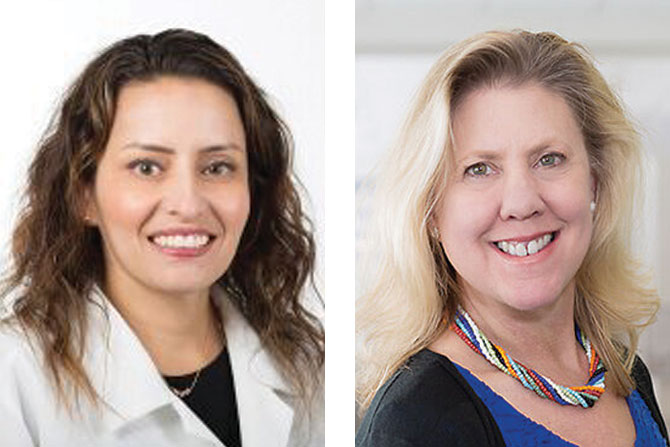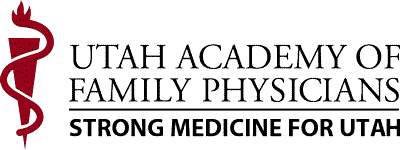Listening and validating, this is what family docs do best. This skill set is critical, and the value of family docs has never been higher than now.
There is a good chance you have seen the names and faces of Dr. Dixie Harris and Dr. Jeanette Brown in the local news lately. That is due to the fact that these two outstanding physicians, who have both spent time at the front lines treating the most critically ill patients with COVID-19 over the past 15 months, and are also treating patients who continue to struggle with COVID-19; sometimes months after their initial symptoms began. This patient population, often referred to as “long haulers,” now have access to even more specialized care in Utah with the opening of the University of Utah Post-COVID Clinic and doctors and research scientists learning more and more everyday about how best to provide care.
In the Thick of It from the Beginning
Dr. Harris is a pulmonologist and critical care physician who also specializes in sleep medicine. While most of her work is done on an outpatient basis at Alta View Hospital in Sandy, Utah, she also performs intensive care (ICU) unit care at Utah Valley Hospital in Provo, Utah and works at the telehealth critical care unit providing support to the network of Intermountain hospitals and clinics throughout the region.
In April 2020, Harris was part of a group of over 100 healthcare providers with Intermountain Healthcare who volunteered to travel to New York City to provide relief and assistance to overwhelmed providers dealing with a surge of very sick patients. Once there, Dr. Harris oversaw nights in an intensive care unit at Northwell Health’s Southside Hospital in Bay Shore, a suburb of New York City, where she pulled repeated 13-hour shifts.
Dr. Jeanette Brown is an internal medicine physician and subspecializes in pulmonary and critical care and subsequently has gained considerable experience treating adult patients in the medical ICU. She also sub-specializes in chronic neuromuscular respiratory failure, so she has been treating critically ill COVID patients who need to be placed on a ventilator, but sees patients with COVID in nearly every phase of the illness. As the medical director for respiratory and complex care at the rehabilitation hospital at the University of Utah, she has been able to see patients that she treated in the ICU as they start on their path to recovery. Often times, she follows the complex cases as outpatients as well.
When the Symptoms Just Will Not Go Away
When Dr. Harris first returned to Utah from New York in the spring of 2020, she was seeing very few patients in the ICU. In the early months of the pandemic in Utah, she was primarily conducting pulmonary consults or conducting telehealth visits in the outpatient setting. Through the summer, more and more patients became ill and like all physicians working in outpatient care, Harris and her colleagues were developing protocols on how to provide care to those patients.
In June, Harris starting seeing patients in the clinic who had been sick with COVID early on but were still struggling with symptoms. Initially, she and other physicians hearing similar stories from patients did not know it was chronic COVID until she started reading articles from New York where they were seeing patients who were still experiencing symptoms months later. One of Harris’ patients in particular was sick with COVID in March, but still had chronic symptoms until late September. That patient never had to be hospitalized for his COVID, only given supplemental oxygen. In those early months, there was little information available to provide guidance for physicians to help these patients. Over the summer, Dr. Harris started researching and found landmark articles that had been published; one out of Italy and one from the British Medical Journal (BMJ). The articles described a high percentage of patients hospitalized with COVID who continued to have symptoms months later. Harris and her colleagues at Intermountain Healthcare began seeing more and more patients with symptoms lasting much longer than you would expect with a typical influenza. Intermountain Healthcare was part of a report on these lingering symptoms in Morbidity and Mortality Weekly Report (MMWR). With more data and information to work with, Harris, along with her colleague, Dr. Eliotte L. Hirshberg, worked with internal and family medicine physicians to develop protocols and care guidelines for Intermountain providers.
The key thing that PCPs can do is doing a really good job of looking at the medications that they were on before and then after the hospitalization. I have seen some really scary mistakes happen in terms of medication management after several care team transitions.
Developing Dedicated Care for Post-COVID Patients
When the University of Utah started discussing the development of a clinic devoted to providing post-COVID care, Dr. Jeanette Brown was a natural fit for designing such a clinic. Most of Dr. Brown’s work is multi-disciplinary in nature as she treats with patients with conditions such as amyotrophic lateral sclerosis (ALS) and muscular dystrophy who require care from multiple specialists to manage their symptoms and improve quality of life. Initially the University of Utah had hoped to develop the post-COVID clinic to be similar to their ALS clinic where patients would come to the clinic and spend around two and half hours there, seeing all of their providers and specialists, who were also able to interface with each other in that space. However, when Dr. Brown and her colleagues started looking at the volume of patients they would be treating, they knew that model would not be possible.
The clinic will treat two types of patients: the patients admitted to the hospital who need post-ICU care and those who were not very sick to begin with, but are still struggling with symptoms months later.
The first population will be seen primarily by physical medicine and rehabilitation (PM&R) physicians and pulmonary clinicians due to the prevalence of respiratory issues in this group. For these patients, the clinic will interface with primary care providers as well, providing notes and updates. Physicians in the clinic can also start making referrals for other specialized care such as neuropsych testing and neurology for those who have had a stroke. There are care pathways in place through e-consults or true consults for all those who need to be referred to for subspecialties.
For those patients in the second population, they can be referred to a primary care physician if they do not already have one. “This can be a great opportunity to get patients connected into primary care; whether they need geriatrics, internal medicine, or family medicine,” Brown states. For patients who have already established care with a provider, those providers will have access to care coordinators and e-consult referrals to get their patients set up with testing if needed.
The Post-COVID Clinic has three primary goals:
- Provide state of the art care for patients and continue to monitor and adapt to the latest best practices.
- Support the providers by helping clinicians through the ambiguity of treating these patients through a learning collaborative. It will involve specialists including Dr. Barbara Jones from the Veterans Administration Hospital in Salt Lake City, Dr. Lucinda Batemen from the Bateman Horne Center, and Dr. Harris from Intermountain Healthcare. The collaborative will take place during lunch hour over Zoom. The format will include presentations on the latest research and then will allow providers time to present cases they are struggling with. Set up much like a tumor board for cancer patients, providers can both ask for and give advice on how to provide treatment in each case.
- Research will also be a large component of the clinic. They are discovering that many patients are altruistic and interested in helping doctors and researchers determine causes and treatment. The clinic will provide multiple opportunities for patients and others from the community to be a part of this ongoing research.
The University of Utah serves an impressive geographical catchment area: Wyoming, Idaho, Montana, Nevada, Arizona, and parts of Colorado. The other closest full post-COVID clinics will be in Colorado, New Mexico, and San Diego, so the University of Utah has the potential to see a large number of patients from hundreds of miles away. To provide care for patients far afield of Salt Lake City, the clinic will be working with primary care doctors throughout the region through telemedicine to determine if patients need further care with specialists. One of Dr. Brown’s greatest concerns is to not squeeze out patients already being seen by the specialists who will now also be caring for those in the post-COVID clinic. Colorado’s clinic, for example, has 400 active patients and their waitlist is 1400. To ensure that does not happen, they have to recruit all the primary care assistance they can as it is going to take time for patients to be seen. And while the clinic is located at the University of Utah’s main hospital complex, most initial visits will be with advanced practice clinicians over telehealth. Resource and time constraints will be aided by the implementation of the learning collaborative so that doctors can learn how to provide care for patients before they are able to be seen by the Post-COVID clinic or other specialists, as getting appointments can take several months.
The Critical Role of Family Physicians in treating Long COVID
Navigating the Medical System
Many people with lingering symptoms may not be used to navigating a complex medical system. Primary care can serve as the “ringleader” of the specialties by providing continuity of care, because many of these patients may need to see several specialists. They are the center piece of these long haulers, helping them migrate through the systems.
Teaching Patience and Providing Validation
It is important to teach patients that sometimes the symptoms from the virus do not go away in two weeks while also screening for more serious side-effects such as a pulmonary embolism. Most of the models where guidelines are being developed are coming through primary care and are holistic in their approach. Dr. Harris says, “I’m just an adjunct to our primary care colleagues. I am lucky that I am on the same floor with family medicine and internal medicine docs. We do a lot of talking back and forth between primary care and specialists about managing patients and what to expect. Primary care is really the driver in most of these patients. We are learning from our patients and sharing information with each other. New guidelines and approaches are being developed all the time.”
Help Patients Pace Themselves and Recognize Their Own Improvement
When Dr. Harris sees patients with long COVID she utilizes patient scales similar to those used when treating anxiety and depression, where patients can rate their symptoms and functionality at each visit. Harris says it can be very therapeutic for patients to be able to see their improvement over time through the use of those scales. She also often performs walking oxygen testing, complete blood count (CBC), checks inflammatory markers, and electrocardiograms (EKG) for patients with any kind of tachyarrhythmia. Dr. Harris also cautions over-exertion for patients, both physical and mental, for long COVID patients as exercise can backfire. Increase in activities should be very gradual and monitored for relapse of symptoms.
Dr. Brown recognizes that one of the most challenging components of caring for patients struggling with debilitating long COVID symptoms is trying to help them navigate qualifying for FMLA or disability coverage as it is resource intensive process and there is no way to bill for that time. For that challenge, unfortunately, she does not have a great answer. She recommends trying to team up with other doctors who are struggling with the increased demand or looking at working with nurses and medical assistants who can potentially devote more time helping patients with the paperwork.
What is the most important advice you can pass on to family physicians?
Dr. Brown emphasizes three key actions for primary care providers to take when their patients have been hospitalized or seen by other specialists: “When you get a discharge summary or notes look at a) what happened, b) what needs to be followed up on and c) does their medication list make sense any longer? The key thing that PCPs can do is doing a really good job of looking at the medications that they were on before and then after the hospitalization. I have seen some really scary mistakes happen in terms of medication management after several care team transitions.”
Dr. Harris states that listening to patients and providing validation is key for patients with long COVID. “Patients are very grateful to their physicians when we sit and listen to them and validate – just to listen and give patients different coaching. One of the biggest things is pacing. In the first few months of treating long COVID patients, I heard about a new, weird symptom almost every day and it was very humbling. [Listening and validating] this is what family docs do best. This skill set is critical, and the value of family docs has never been higher than now.”
Find more resources about caring for long COVID-19 patients at utahafp.org/longcovid.









